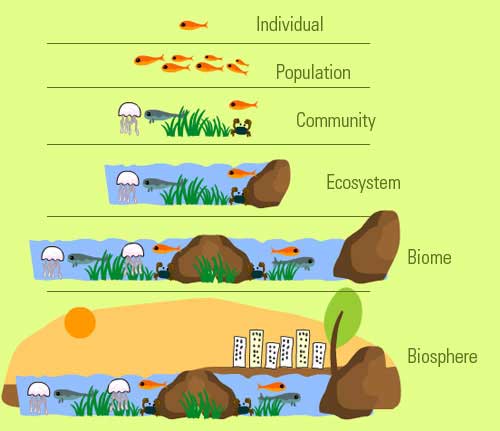Ecosystem
Ecological Organisation
There are 4 levels of ecological organisation. It starts at the lowest level: individual organisms, then populations, then communities, then finally to the whole ecosystem.
Individual species of living organisms include every single plant and animal species that can be found on our planet. It includes also includes bacteria and fungi.
A population is when you have a specific group of species that can live together in a specific area. For example, you can have a herd of wildebeests living in African Savannah.
Next is the community, where each species depends on other species for food, shelter, pollination, seed dispersal etc. If one species is removed it can affect the whole community. This is called interdependence. A stable community is one where all the species and environmental factors are in balance so that population sizes remain fairly constant.
Finally, the ecosystem is the biological environment that includes all living and non-living things (e.g. air, soil and water) in a specific region, and the interactions that take place between them. To survive and reproduce, organisms require a supply of materials from their surroundings and from the other living organisms there. Plants in a community or habitat often compete with each other for light and space, and for water and mineral ions from the soil. Animals often compete with each other for food, mates and territory.
Abiotic Biotic Factors
Communities can be affected by abiotic and biotic factors.
Abiotic Factors (Non-living physical factors that can affect living organisms in the community):
- If there is a low temperature, there will be less photosynthesis. Low temperature would limit the growth in plants. This is why there are normally less species living in colder climates.
- If there is a low light intensity, there will be less photosynthesis. This will create less food for the animals that would feed on the plants to survive. Some plants may become adapted by having bigger leaves or a waxy layer so that it can optimise the process of photosynthesis.
- If there is a low level of water, plants and animals would not survive as water is vital for survival.
- If there is a high level of pollution, animals would suffer as it affects their breathing system.
- Soil pH and mineral content can also affect the plant growth.
- Wind intensity and direction can also affect the plant growth.
- Carbon dioxide levels can also affect the rate of photosynthesis in plants.
- High oxygen levels are beneficial for aquatic animals.
Biotic Factors (living organisms that affect another living organism in an environment):
- If there is a shortage of food, animals will struggle to survive. This will mean that they will reproduce less as they fail to compete for food.
- If there are new pathogens and parasites, organisms may be less healthy as they are not resistant to the new pathogens and parasites. This may kill an entire community if they are not prepared.
- If there are more predators arriving, organisms that cannot defend themselves will die off.
- If one type of species is outcompeting another, it may affect the ability for the other species to breed as the population goes down.
Adaptations
Some organisms are adapted to live in their natural environment, making it easier for them to survive. Organisms have features (adaptations) that enable them to survive in the conditions in which they normally live. These adaptations may be structural, behavioural or functional.
Some organisms live in environments that are very extreme, such as at high temperature, pressure, or salt concentration. These organisms are called extremophiles. Bacteria living in deep sea vents are extremophiles.
For example, camels are adapted to live in extremely hot and dry conditions. They have the following adaptations:
- Large and flat feet that enables them to spread their weight on the sand
- Thick fur on the top of their body to provide shade, whilst they have short fur elsewhere to enable heat loss to take place quickly
- They lose a low volume of water through urinating and sweating
- Two rows of eyelashes and slit-like nostrils to prevent sand from entering
- Able to tolerate high temperatures
- What is interdependence?
- Your answer should include: Specie / Depends / Another / Species
Explanation: Once one specie depends on another species in order to survive (and vice versa). - What is the effect of a low light intensity on the rate of photosynthesis?
- Your answer should include: Decrease / Rate / Photosynthesis / Less / Sunlight
Explanation: It will decrease the rate of photosynthesis because there is less sunlight to allow photosynthesis to take place. - Why do camels have two rows of eyelashes, and slit-like nostrils?
- Your answer should include: Prevents / Sand / Entering / Eyes
Explanation: Prevents sand from entering their eyes.
